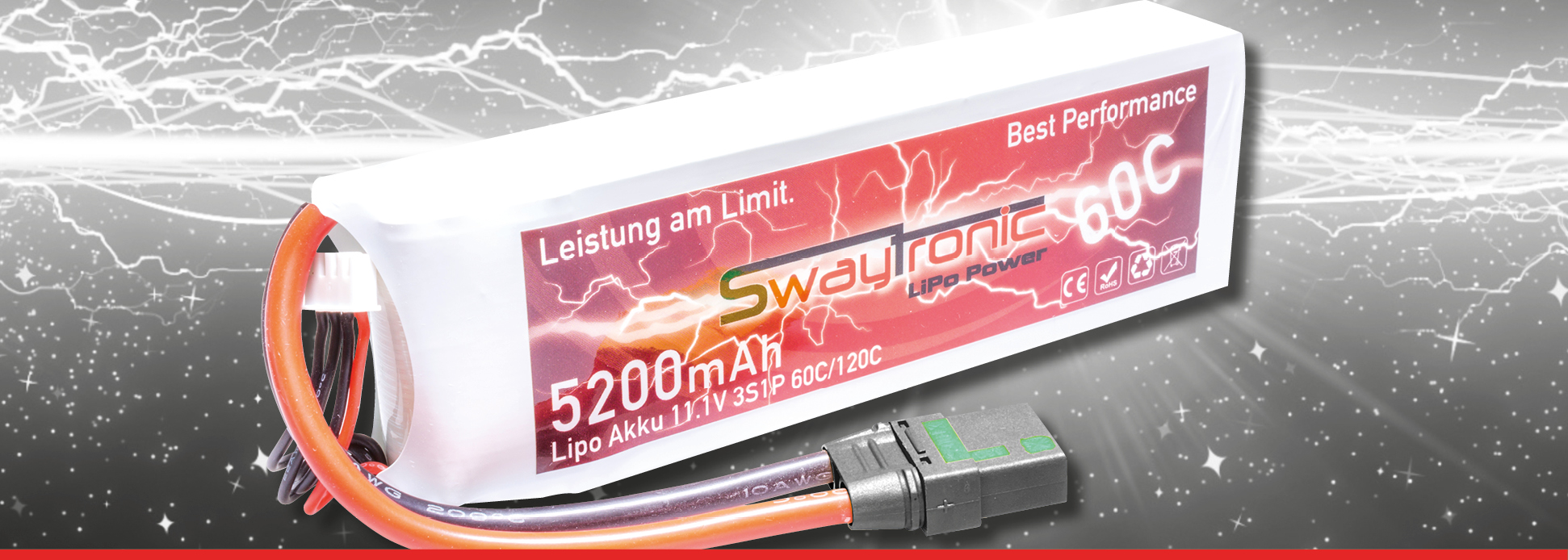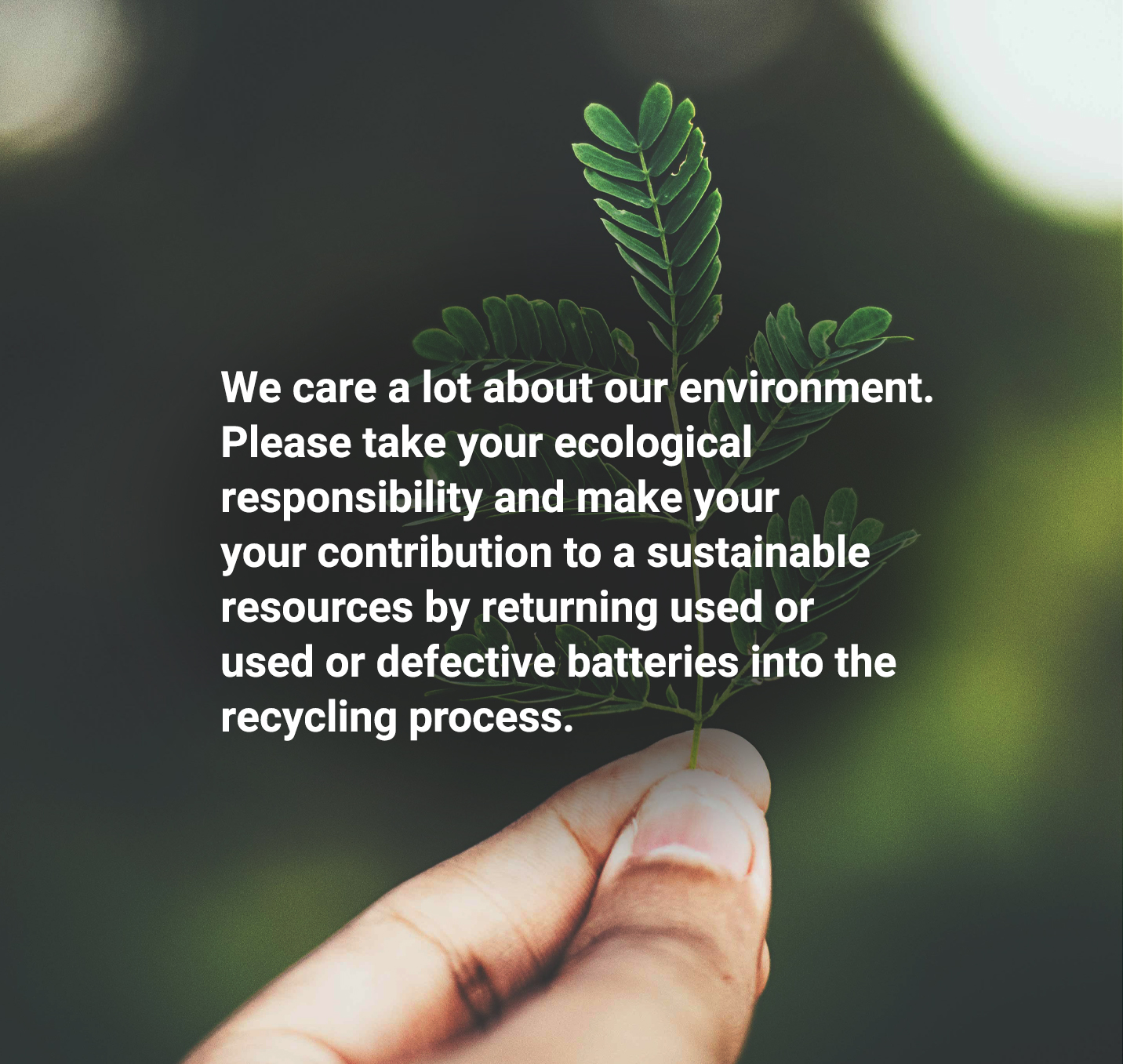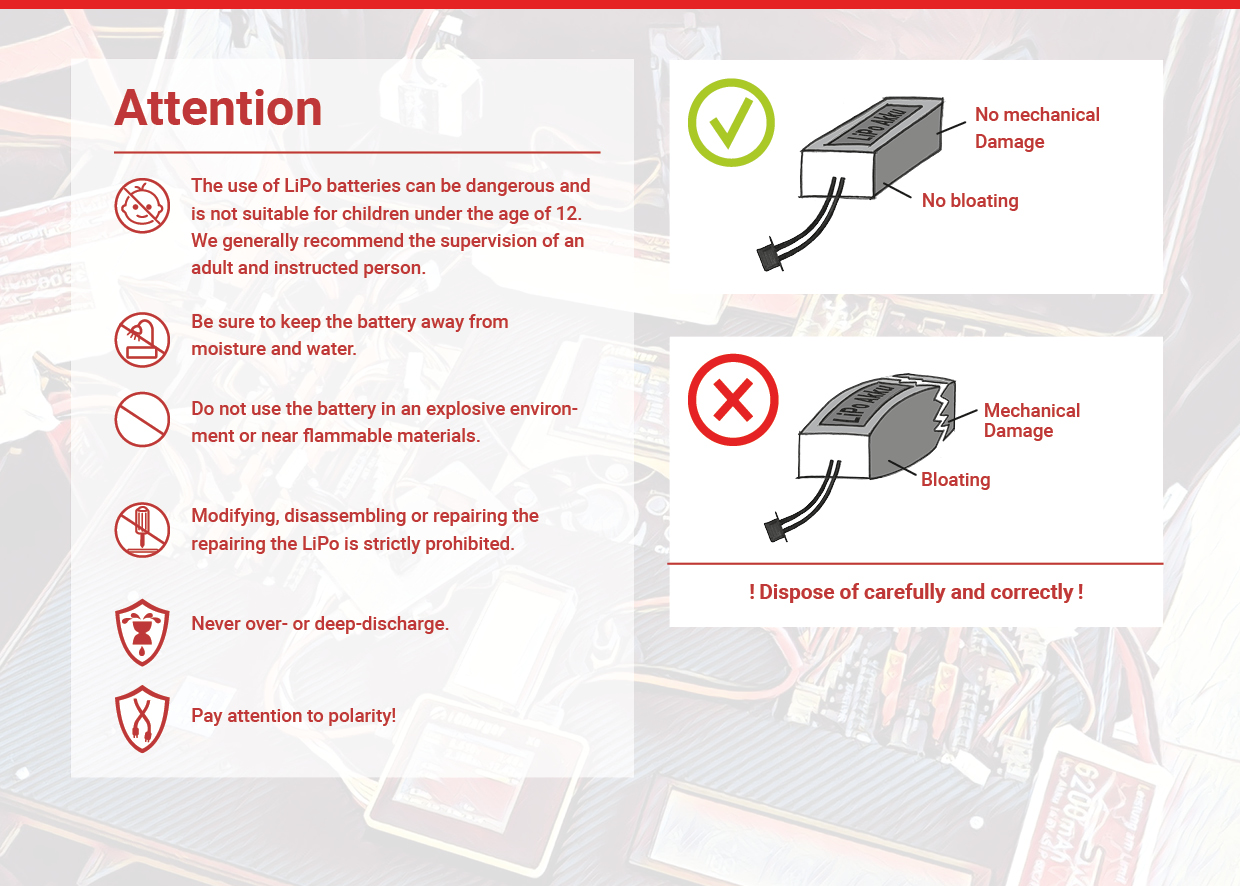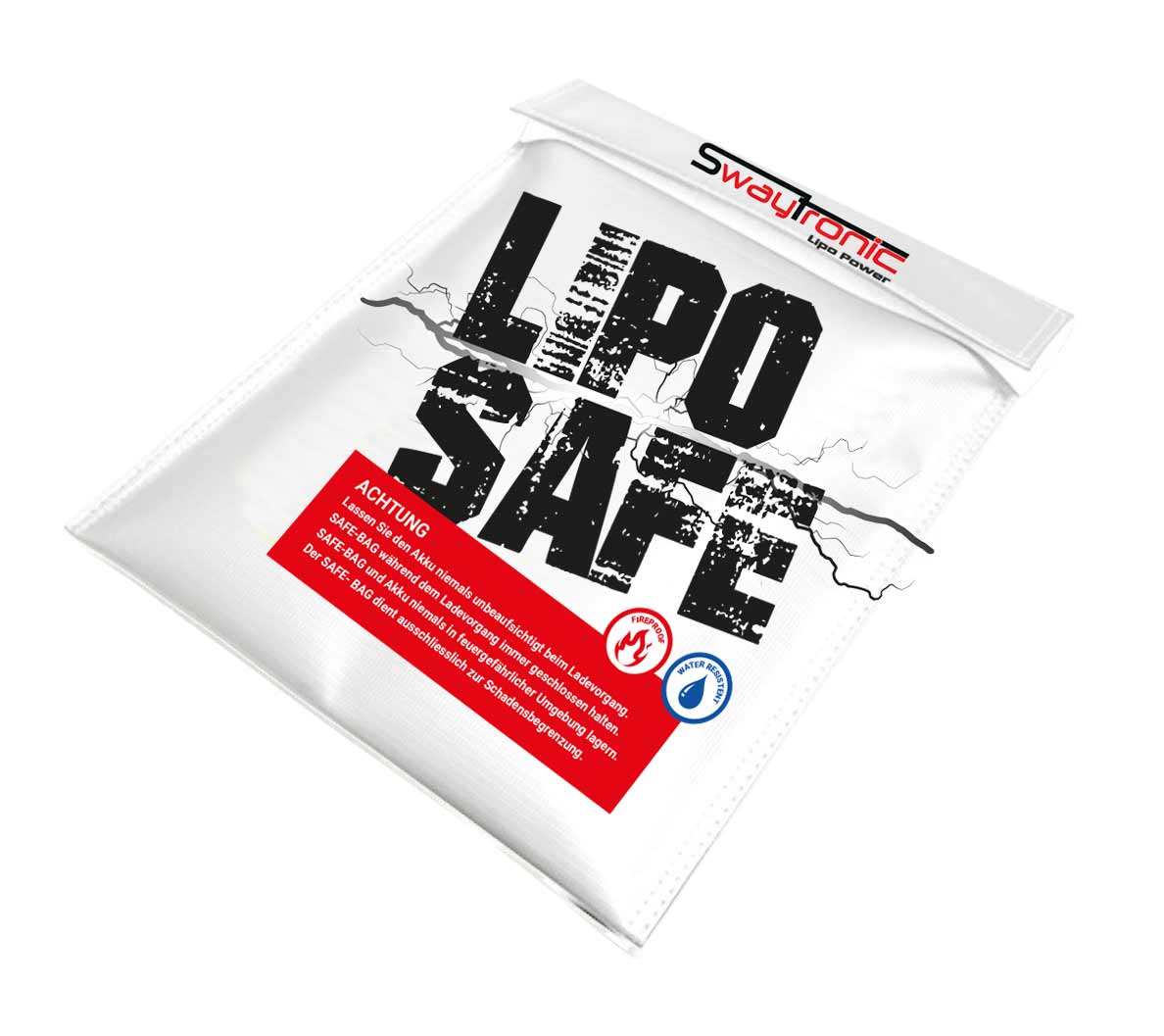
Safety and performance
in handling lithium polymer batteries
Your safety is important to us! That is why we have developed a concept for you, with the help of which safe handling of lithium-polymer batteries can be guaranteed. At the same time, you will receive tips on how to extend the service life of your battery and exploit its maximum performance.
Therefore, please familiarise yourself with the following safety regulations and instructions. After all, it is about your safety, but also about the safety of your fellow human beings and our environment. The concept is divided into the four areas "Loading", "Operation", "Storage and Transport" and "Environment and Sustainability" and includes safety regulations as well as information on optimising performance.

General information
- Due to the high energy density of the lithium-polymerbattery, there is an increased risk of explosion, fire and injury.
- Always observe the correct polarity when connecting (plus/minus).
- Never create a short circuit.
- Do not subject the battery to mechanical and never open the battery pack or the individual cells.
- Never expose the battery to high pressure, temperatures above 60°C or microwaves.
- Never create your own configurations and refrain from soldering individual cells. Never solder or combine cells of different types, capacities or different designs.
- Check the battery for damage after crashes for damage after crashes or the like.
- If you notice damage or flatulence on the battery pack or individual cells, the battery must be disposed of properly without delay. Observe the information in the chapter "Environment and sustainability".
- Observe marked danger areas where the use, charging or storage of LiPo batteries and/or lithium cells is prohibited in any case.
- The specifications and voltage limits refer to lithium-polymer batteries and would have to be adjusted if LiPo HV, Li-Ion, LiFe etc. are used.
- The nominal voltage of a LiPo cell is 3.7V (LiPo HV 3.8V) and the final charge voltage is 4.2 volts (LiPo HV 4.35V). The voltage of the individual cells must never drop below 3.0V. The LiPo cells are therefore always within a voltage window of 3.0 - 4.2V.

Shop

- Only charge or discharge undamaged and non-blown batteries. Check the battery for damage after each use/crash and do not take any risks.
- Make sure that batteries are never charged unattended so that you can react at any time in case of a problem.
- Only use a charger that is expressly approved for the type of battery in question. All other charging methods are dangerous and must be avoided at all costs. Contact us in case of doubt.
- Make sure that you fully charge a brand new battery with a balancer charger before using it for the first time.
- Use a charger with a balancer to compensate for voltage differences between individual cells that may occur when discharging/using the battery. Make sure to connect the separate balancer plug.
- Make sure that the charging and discharging rates prescribed by the manufacturer are not exceeded. A charge rate of 1-2C is recommended for Swaytronic batteries (e.g. 2C for a 3000mAh LiPo=charge current of 6A). Low charging currents protect the battery. However, the maximum charge rate for 35C-60C batteries is 5C, or 8C for 60C-200C Swaytronic batteries.
- Check/define the operating voltage limits (min/max) in the charger for the respective battery technology (e.g. LiPo) to avoid explosions, fires or similar.
- Make sure that the ambient temperature during charging is between 15°C and 25°C and avoid direct sunlight or other sources of heat. Never place the battery on a conductive surface (risk of fire/injury) and use a fireproof base instead.
- Do not infer the state of charge from the voltage, as the voltage drop is not linear to the capacity.
- After charging, remove the battery from the charger immediately and store it in a product designed for this purpose (Swaytronic LiPo Safebag) when not in use.

Operation

- Before using the battery, check the voltage of the individual cells using a voltage tester to prevent damage. Voltage deviations should not exceed ΔV 30mV.
- Never discharge your battery below 3.0V/cell during operation, otherwise there is a risk of fire and explosion. Calculate your operating time DoD (Depth of Discharge) (=capacity/measured current consumption) and plan a reserve of at least 10-15 %.
- Make sure that a temperature of 60°C measured on the cell surface is not exceeded after discharge/operation. Optimal is approx. 25°C to 40°C. Check the change to Swaytronic high-performance cells (>60C) if the battery becomes too hot.
- Extend the EoL (End of Life) of your battery by always leaving at least 20% of the capacity in the battery. For example, for a 2500mAh battery, do not draw more than 2000mAh and remember that the maximum capacity of the battery decreases over time.

Storage and transport

Always store and transport the battery in a fireproof, insulated but not airtight container. When not in use, store the battery at a cell voltage of approx. 3.80-3.85V (approx. half charged) and low humidity. Never store the battery fully charged. In addition to the charge level and humidity, also take the storage temperature into account. This also influences the ageing process. Store the battery in a cool room at 10-20°C.
Make sure that the battery is not exposed to strong vibrations, shocks or high temperatures during transport. Charge and discharge the battery 1-3 times every three months, even when not in use, to ensure the longevity of the battery and take into account the self-discharge of a lithium polymer battery, which is approx. 4-5% per year. Keep the battery away from liquids of all kinds and moisture. Do not allow children to access the battery.

Certifications

Emergency

We spare no effort for your safety. That is why we subject our batteries to comprehensive tests. The CE (Conformité Européenne) certification guarantees that the European safety standards are met. Swaytronic batteries meet the international safety standard for lithium ion battery products according to 62133-2:2017. Furthermore, the batteries are tested for their electromagnetic compatibility (EMC/EMI). Namely, they meet the requirements of EN 61000-6-1 and EN 61000-6-3, which examine immunity and emitted interference for residential, commercial and small business applications. Swaytronic batteries also comply with the RoHS (Restriction of Hazardous Substances) directives, which regulate and consequently restrict the use and marketing of hazardous substances in electrical equipment and the like.
- Alert the fire brigade (118 in Switzerland) according to the situation.
- Close off the danger area.
- Make sure that all persons leave the fire area against the wind.
- Avoid inhaling smoke and fumes (risk of poisoning). Consult the emergency number 145 in case of poisoning or suspected poisoning.
- Do not attempt to extinguish the fire with water (risk of explosion).
- Instead, use dry sand, fire extinguishers/foam extinguishers or fire blankets as extinguishing agents.
- Approach the fire site with a tailwind and use the extinguishing agent courageously and according to instructions.

Trainings
We create the perspective!
Learn everything there is to know about LiPo batteries and their safe handling. Or would you like to learn how to optimise LiPo performance and ensure longevity? - In any case, we have just the right offer for you. Our training courses on safety and performance in handling lithium polymer batteries are aimed at interested individuals, companies and model building clubs

